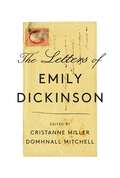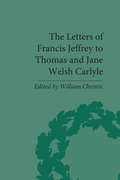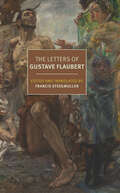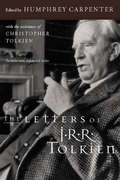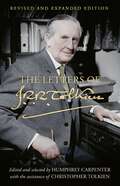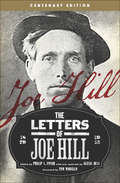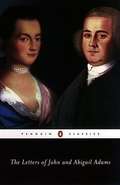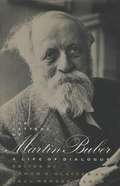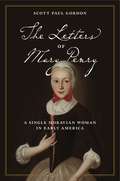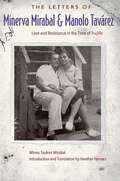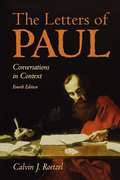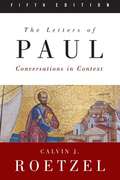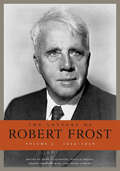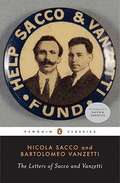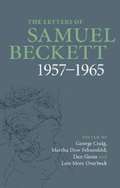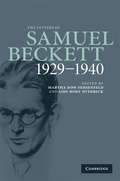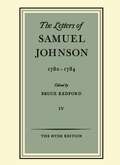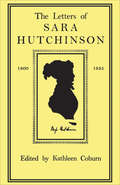- Table View
- List View
The Letters of Emily Dickinson
by Emily DickinsonThe definitive edition of Emily Dickinson’s correspondence, expanded and revised for the first time in over sixty years.Emily Dickinson was a letter writer before she was a poet. And it was through letters that she shared prose reflections—alternately humorous, provocative, affectionate, and philosophical—with her extensive community. While her letters often contain poems, and some letters consist entirely of a single poem, they also constitute a rich genre all their own. Through her correspondence, Dickinson appears in her many facets as a reader, writer, and thinker; social commentator and comedian; friend, neighbor, sister, and daughter.The Letters of Emily Dickinson is the first collected edition of the poet’s correspondence since 1958. It presents all 1,304 of her extant letters, along with the small number available from her correspondents. Almost 300 are previously uncollected, including letters published after 1958, letters more recently discovered in manuscript, and more than 200 “letter-poems” that Dickinson sent to correspondents without accompanying prose. This edition also redates much of her correspondence, relying on records of Amherst weather patterns, historical events, and details about flora and fauna to locate the letters more precisely in time. Finally, updated annotations place Dickinson’s writing more firmly in relation to national and international events, as well as the rhythms of daily life in her hometown. What emerges is not the reclusive Dickinson of legend but a poet firmly embedded in the political and literary currents of her time.Dickinson’s letters shed light on the soaring and capacious mind of a great American poet and her vast world of relationships. This edition presents her correspondence anew, in all its complexity and brilliance.
The Letters of Francis Jeffrey to Thomas and Jane Welsh Carlyle (The Pickering Masters)
by William ChristieContains letters from Francis Jeffrey (1773-1850) to Thomas Carlyle (1795-1881) and Jane Welsh Carlyle (1801-1866). The letters in this title present a personal and intellectual narrative of nineteenth-century Britain.
The Letters of Franklin K. Lane
by Louise Herrick Wall Anne Wintermute Franklin K. LaneA selection of letters written by Franklin K. Lane.
The Letters of Gustave Flaubert: Collected Letters Of The Most Influential French Authors
by Gustave Flaubert&“If there is one article of faith that dominates the Credo of Gustave Flaubert&’s correspondence,&” Francis Steegmuller writes in the introduction to this selection of Flaubert&’s letters, &“it is that the function of great art is not to provide &‘answers.&’&” The Letters of Gustave Flaubert is above all a record of the intransigent questions—personal, political, artistic—with which Flaubert struggled throughout his life.Here we have Flaubert&’s youthful, sensual outpourings to his mistress, the poet Louise Colet, and, as he advances, still unknown, into his thirties, the wrestle to write Madame Bovary. We hear, too, of his life-changing trip to Egypt, as described to family and friends, and then there are lively exchanges with Baudelaire, with the influential critic Sainte-Beuve, and with Guy de Maupassant, his young protégé. Flaubert&’s letters to George Sand reveal her as the great confidante of his later years.Steegmuller&’s book, a classic in its own right, is both a splendid life of Flaubert in his own words and the ars poetica of the master who laid the foundations for modern writers from James Joyce to Lydia Davis. Originally issued in two volumes, the book appears here for the first time under a single cover.
The Letters of J. R. R. Tolkien
by J. R. R. Tolkien Humphrey CarpenterThis collection will entertain all who appreciate the art of masterful letter writing. The Letters of J.R.R Tolkien sheds much light on Tolkien's creative genius and grand design for the creation of a whole new world: Middle-earth. Featuring a radically expanded index, this volume provides a valuable research tool for all fans wishing to trace the evolution of THE HOBBIT and THE LORD OF THE RINGS.
The Letters of J.R.R. Tolkien: Revised and Expanded Edition
by J.R.R. TolkienThe comprehensive collection of letters spanning the adult life of one of the world’s greatest storytellers, now revised and expanded to include more than 150 previously unseen letters, with revealing new insights into The Hobbit, The Lord of the Rings and The Silmarillion.J.R.R. Tolkien, creator of the languages and history of Middle-earth as recorded in The Hobbit, The Lord of the Rings and The Silmarillion, was one of the most prolific letter-writers of the last century. Over the years he wrote a mass of letters—to his publishers, to members of his family, to friends, and to “fans” of his books—which often reveal the inner workings of his mind, and which record the history of composition of his works and his reaction to subsequent events.A selection from Tolkien’s correspondence, collected and edited by Tolkien’s official biographer, Humphrey Carpenter, and assisted by Christopher Tolkien, was published in 1981. It presented, in Tolkien’s own words, a highly detailed portrait of the man in his many aspects: storyteller, scholar, Catholic, parent, friend, and observer of the world around him.In this revised and expanded edition of The Letters of J.R.R. Tolkien, it has been possible to go back to the editors’ original typescripts and notes, restoring more than 150 letters that were excised purely to achieve what was then deemed a “publishable length.” and present the book as originally intended.Enthusiasts for his writings will find much that is new, for the letters not only include fresh information about Middle-earth, such as Tolkien’s own plot summary of the entirety of The Lord of the Rings and a vision for publishing his “Tales of the Three Ages,” but also many insights into the man and his world. In addition, this new selection will entertain anyone who appreciates the art of letter-writing, of which J.R.R. Tolkien was a master.
The Letters of Joe Hill: Centenary Edition
by Joe HillThe legendary songwriter and labor rights activist reveals his personal struggles and political philosophy in this collection of letters.As a proud member of the Industrial Workers of the World, Joe Hill dedicated his life to the union cause. The original bard of the working class, he spread a message of solidarity and struggle through unforgettable, bitingly satirical songs. But after a suspicious arrest and controversial trial, Hill was convicted of murder in 1914. A year later, he was put to death by the capitalist state.In this collection of letters, many of which were written from prison in Salt Lake City, readers get to know the man behind the legendary songs. Hill corresponds with friends and fellow workers, discussing his case, his life, his music, and cheering on the Wobblies even as he faces death.“Joe Hill's influence is everywhere. Without Joe Hill, there's no Woody Guthrie, no Dylan, no Springsteen, no Clash, no Public Enemy, no Minor Threat, no System of a Down, no Rage Against the Machine.” —Tom Morello, from the foreword
The Letters of John and Abigail Adams
by John Adams Frank Shuffelton Abigail AdamsThe Letters of John and Abigail Adams provides an insightful record of American life before, during, and after the Revolution; the letters also reveal the intellectually and emotionally fulfilling relationship between John and Abigail that lasted fifty-four years and withstood historical upheavals, long periods apart, and personal tragedies. Covering key moments in American history-the Continental Congress, the drafting of the Declaration of Independence, the Revolutionary War, and John Adams's diplomatic missions to Europe-the letters reveal the concerns of a couple living during a period of explosive change, from smallpox and British warships to raising children, paying taxes, the state of women, and the emerging concepts of American democracy. .
The Letters of Martin Buber
by Martin Buber"No matter how brilliant it may be, the human intellect that wishes to keep to a plane above the events of the day is not really alive," wrote Martin Buber in 1932. The correspondence of Martin Buber reveals a personality passionately involved in all the cultural and political events of his day. Drawn from the three-volume German edition of his correspondence, this collection includes letters both to and from the leading personalities of his day--Albert Einstein and Albert Schweitzer, Hemann Hesse, Franz Kafka, and Stefan Zweig, Theodor Herzl, Chaim Weizmann, David Ben-Gurion, S.Y. Agnon, Gershom Scholem, and Franz Rosenzweig. These exchanges capture the dynamics of seven decades of lived history, reflected through the eyes of a man who was the conscience of his generation. One of the leading spiritual thinkers of the twentieth century, Buber is best known for his work of religious existentialism, I and Thou. A prime mover in the German-Jewish renaissance of the 1920s, he taught comparative religion and Jewish ethics at the University of Frankfurt. Fleeing the Nazis in 1938, Buber made his home in Jerusalem, where he taught social philosophy at the Hebrew University. As resident sage of Jerusalem, he developed an international reputation and following, and carried on a vigorous correspondence on social, political, and religious issues until the end of his life. Included in this collection are Buber's exchanges with many Americans in the latter part of his life: Will Herberg, Walter Kaufmann, Maurice Friedman, Malcolm Diamond, and other individuals who sought his advice and guidance. In the voices of these letters, a full-blooded portrait emerges of a towering intellect ever striving to live up to philosophy of social engagement.
The Letters of Mary Penry: A Single Moravian Woman in Early America (Pietist, Moravian, and Anabaptist Studies #4)
by Scott Paul GordonIn The Letters of Mary Penry, Scott Paul Gordon provides unprecedented access to the intimate world of a Moravian single sister. This vast collection of letters—compiled, transcribed, and annotated by Gordon—introduces readers to an unmarried woman who worked, worshiped, and wrote about her experience living in Moravian religious communities at the time of the American Revolution and early republic. Penry, a Welsh immigrant and a convert to the Moravian faith, was well connected in both the international Moravian community and the state of Pennsylvania. She counted among her acquaintances Elizabeth Sandwith Drinker and Hannah Callender Sansom, two American women whose writings have also been preserved, in addition to members of some of the most prominent families in Philadelphia, such as the Shippens, the Franklins, and the Rushes. This collection brings together more than seventy of Penry’s letters, few of which have been previously published. Gordon’s introduction provides a useful context for understanding the letters and the unique woman who wrote them. This collection of Penry’s letters broadens perspectives on early America and the eighteenth-century Moravian Church by providing a sustained look at the spiritual and social life of a single woman at a time when singleness was extraordinarily rare. It also makes an important contribution to the recovery of women’s voices in early America, amplifying views on politics, religion, and social networks from a time when few women’s perspectives on these subjects have been preserved.
The Letters of Mary Penry: A Single Moravian Woman in Early America (Pietist, Moravian, and Anabaptist Studies)
by Scott Paul GordonIn The Letters of Mary Penry, Scott Paul Gordon provides unprecedented access to the intimate world of a Moravian single sister. This vast collection of letters—compiled, transcribed, and annotated by Gordon—introduces readers to an unmarried woman who worked, worshiped, and wrote about her experience living in Moravian religious communities at the time of the American Revolution and early republic. Penry, a Welsh immigrant and a convert to the Moravian faith, was well connected in both the international Moravian community and the state of Pennsylvania. She counted among her acquaintances Elizabeth Sandwith Drinker and Hannah Callender Sansom, two American women whose writings have also been preserved, in addition to members of some of the most prominent families in Philadelphia, such as the Shippens, the Franklins, and the Rushes. This collection brings together more than seventy of Penry’s letters, few of which have been previously published. Gordon’s introduction provides a useful context for understanding the letters and the unique woman who wrote them. This collection of Penry’s letters broadens perspectives on early America and the eighteenth-century Moravian Church by providing a sustained look at the spiritual and social life of a single woman at a time when singleness was extraordinarily rare. It also makes an important contribution to the recovery of women’s voices in early America, amplifying views on politics, religion, and social networks from a time when few women’s perspectives on these subjects have been preserved.
The Letters of Minerva Mirabal and Manolo Tavárez: Love and Resistance in the Time of Trujillo
by Minou Tavárez MirabalFor the first time in English, the stories of two Dominican national icons in their own words The letters between Dominican revolutionaries Minerva Mirabal Reyes and Manolo Tavárez Justo tell an intimate story of life and love under the brutal dictatorship of Rafael Trujillo, who held power in the nation from 1930 to 1961. Leaders in the 14 of June Movement, Minerva and Manolo were imprisoned multiple times. Minerva—one of three Mirabal sisters known by the code name “Las Mariposas” (The Butterflies)—was assassinated with her sisters in 1960; Manolo was killed in 1963. This translation and critical edition of their correspondence brings their stories to the English-language readers of the world. Paired with commentary from the couple’s daughter, political activist Minou Tavárez Mirabal, these 117 letters and telegrams span from the first notes Minerva and Manolo exchanged while courting in law school to the last message Manolo sent to 7-year-old Minou before his murder. Translator Heather Hennes introduces the collection with a history of the Trujillo regime and its opposition, and the book includes a foreword by Michelle Bachelet, United Nations High Commissioner for Human Rights. Through this volume, readers will discover the human complexities of the iconic and much-mythologized “Butterfly” Minerva and will appreciate the importance of the couple’s legacy in the politics and democratic growth of the country today.Publication of this work made possible by a Sustaining the Humanities through the American Rescue Plan grant from the National Endowment for the Humanities.
The Letters of Paul: Conversations in Context
by Calvin J. Roctzeldiscussion of Paul in historical context
The Letters of Paul: Conversations in Context, Fifth Edition
by Calvin J. RoetzelThis 5th edition has been updated the reflect developments in the scholarship since 1998. It is an introduction to St. Paul and his writings, aimed at students.
The Letters of Private Wheeler: An eyewitness in action at the Battle of Waterloo (MILITARY MEMOIRS)
by B.H. Liddell Hart'In a later age he would have become a successful war correspondent ... We have no more human account of the Peninsular War from a participant in all its battles. Vivid images - of people, landscapes, events - flows from his pen ... One of military history's great originals' John Keegan, DAILY TELEGRAPHThese letters, in the form of a frank and amusing diary, were written by a private in Wellington's army who fought throughout the Napoleonic Wars. Private Wheeler's record covers the Peninsular Campaign, keeping order during the coronation of Louis XVIII (whom he called 'an old bloated poltroon') and his later posting to Corfu.Most of all, Wheeler's account of the historic Battle of Waterloo - written before the muskets of battle had cooled - reveals him to be a master of lively anecdote and mischievous characterisation.
The Letters of Private Wheeler: An eyewitness in action at the Battle of Waterloo (MILITARY MEMOIRS)
by B.H. Liddell Hart'In a later age he would have become a successful war correspondent ... We have no more human account of the Peninsular War from a participant in all its battles. Vivid images - of people, landscapes, events - flows from his pen ... One of military history's great originals' John Keegan, DAILY TELEGRAPHThese letters, in the form of a frank and amusing diary, were written by a private in Wellington's army who fought throughout the Napoleonic Wars. Private Wheeler's record covers the Peninsular Campaign, keeping order during the coronation of Louis XVIII (whom he called 'an old bloated poltroon') and his later posting to Corfu.Most of all, Wheeler's account of the historic Battle of Waterloo - written before the muskets of battle had cooled - reveals him to be a master of lively anecdote and mischievous characterisation.
The Letters of Robert Frost
by Robert FrostOne of the acknowledged giants of twentieth-century American literature, Robert Frost was a public figure much celebrated in his day. Although his poetry reached a wide audience, the private Frost--pensive, mercurial, and often very funny--remains less appreciated. Following upon the publication of Frost's notebooks and collected prose, "The Letters of Robert Frost" is the first major edition of the poet's written correspondence. The hundreds of previously unpublished letters in these annotated volumes deepen our understanding and appreciation of this most complex and subtle of verbal artists. Volume One traverses the years of Frost's earliest poems to the acclaimed collections "North of Boston "and "Mountain Interval "that cemented his reputation as one of the leading lights of his era. The drama of his personal life--as well as the growth of the audacious mind that produced his poetry--unfolds before us in Frost's day-to-day missives. These rhetorical performances are at once revealing and tantalizingly evasive about relationships with family and close friends, including the poet Edward Thomas. We listen in as Frost defines himself against contemporaries Ezra Pound and William Butler Yeats, and we witness the evolution of his thoughts about prosody, sound, style, and other aspects of poetic craft. In its literary interest and sheer display of personality, Frost's correspondence is on a par with the letters of Emily Dickinson, Robert Lowell, and Samuel Beckett. "The Letters of Robert Frost" holds hours of pleasurable reading for lovers of Frost and modern American poetry.
The Letters of Robert Frost, Volume 2
by Robert FrostThe second installment of Harvard's critically acclaimed five-volume edition of Robert Frost's correspondence contains letters from 1920 to 1928, 400 of them gathered here for the first time. His 160 correspondents include family, friends, colleagues, fellow writers, visual artists, publishers, educators, librarians, farmers, and admirers.
The Letters of Robert Frost, Volume 3: 1929-1936
by Robert FrostThe third installment of Harvard’s five-volume edition of Robert Frost’s correspondence. The Letters of Robert Frost, Volume 3: 1929–1936 is the latest installment in Harvard’s five-volume edition of the poet’s correspondence. It presents 589 letters, of which 424 are previously uncollected. The critically acclaimed first volume, a Times Literary Supplement Book of the Year, included nearly 300 previously uncollected letters, and the second volume 350 more. During the period covered here, Robert Frost was close to the height of his powers. If Volume 2 covered the making of Frost as America’s poet, in Volume 3 he is definitively made. These were also, however, years of personal tribulation. The once-tight Frost family broke up as marriage, illness, and work scattered the children across the country. In the case of Frost’s son Carol, both distance and proximity put strains on an already fractious relationship. But the tragedy and emotional crux of this volume is the death, in Montana, of Frost’s youngest daughter, Marjorie. Frost’s correspondence from those dark days is a powerful testament to the difficulty of honoring the responsibilities of a poet’s eminence while coping with the intensity of a parent’s grief. Volume 3 also sees Frost responding to the crisis of the Great Depression, the onset of the New Deal, and the emergence of totalitarian regimes in Europe, with wit, canny political intelligence, and no little acerbity. All the while, his star continues to rise: he wins a Pulitzer for Collected Poems in 1931 and will win a second for A Further Range, published in 1936, and he is in constant demand as a public speaker at colleges, writers’ workshops, symposia, and dinners. Frost was not just a poet but a poet-teacher; as such, he was instrumental in defining the public functions of poetry in the twentieth century. In the 1930s, Frost lived a life of paradox, as personal tragedy and the tumults of politics interwove with his unprecedented achievements. Thoroughly annotated and accompanied by a biographical glossary and detailed chronology, these letters illuminate a triumphant and difficult period in the life of a towering literary figure.
The Letters of Sacco and Vanzetti
by Nicola Sacco Bartolomeo VanzettiCommemorating the eightieth anniversary of Sacco and Vanzetti's execution- with a new cover and new foreword Electrocuted in 1927 for the murder of two guards in Massachusetts, the Italian- American anarchists Nicola Sacco and Bartolomeo Vanzetti defied the verdict against them, maintaining their innocence to the end. Whether they were guilty continues to be the subject of debate today. First published in 1928, Sacco and Vanzetti's letters represent one of the great personal documents of the twentieth century: a volume of primary source material as famous for the splendor of its impassioned prose as for the brilliant light it sheds on the characters of the two dedicated anarchists who became the focus of worldwide attention. .
The Letters of Samuel Beckett 1957-1965 Volume 3
by Samuel Beckett Martha Dow Fehsenfeld Lois More Overbeck George Craig Dan GunnThis third volume of The Letters of Samuel Beckett focuses on the years when Beckett is striving to find a balance between the demands put upon him by his growing international fame, and his need for the peace and silence from which new writing might emerge. This is the period in which Beckett launches into work for radio, film and, later, into television. It also marks his return to writing fiction, with his first major piece for a decade, Comment c'est (How It Is). Where hitherto he has been reticent about the writing process, now he devotes letter after letter to describing and explaining his work in progress. For the first time Beckett has a woman as his major correspondent: a relationship shown in his intense and abundant letters to Barbara Bray. The volume also provides critical introductions, chronologies, explanatory notes and profiles of Beckett's main correspondents.
The Letters of Samuel Beckett, 1929-1940
by Samuel Beckett Martha Dow Fehsenfeld Lois More Overbeck George Craig Daniel Gunn Dan GunnThe letters written by Samuel Beckett between 1929 and 1940 provide a vivid and personal view of Western Europe in the 1930s, and mark the gradual emergence of Beckett's unique voice and sensibility. The Cambridge University Press edition of The Letters of Samuel Beckett offers for the first time a comprehensive range of letters of one of the greatest literary figures of the twentieth century. Selected for their bearing on his work from over 15,000 extant letters, the letters published in this four-volume edition encompass sixty years of Beckett's writing life (1929-1989), and include letters to friends, painters and musicians, as well as to students, publishers, translators, and colleagues in the world of literature and theatre. For anyone interested in twentieth-century literature and theatre this edition is essential reading, offering not only a record of Beckett's achievements but a powerful literary experience in itself.
The Letters of Samuel Johnson 1782-1784 (The Hyde Edition #Vol. IV)
by Samuel JohnsonThis epistolary endgame includes the breakup of the friendship with Hester Thrale, medical dramas of every description, and a poignant reaching out to new friends and new experiences. The letters of 1782-84 exemplify in abundance what Johnson himself praises and provides, 'the interchange of that social officiousness by which we are habitually endeared to one another.
The Letters of Sara Hutchinson
by Kathleen Coburn Sara HutchinsonSarah Hutchinson has never been much more than a name, though a name connected with some of the greatest in English literature. The sister of Mrs. Wordsworth, and a member of the Wordsworth household for thirty years, Coleridge's beloved Asra to whom many of his poems were written, Southey's friend and Lamb's, and a guest of the Arnolds at Rugby, she was a member of an interesting circle. For her intimate relations to Wordsworth and Coleridge it has long been apparent that we should like to know her better. Now her letters to members of her family and to friends demonstrate how worthwhile it is to know her for herself as well.<P><P>The letters come from the family and from the Wordsworth collection at Dove Cottage and are here printed (almost in full) for the first time.<P>They show a lively and amusing woman, kind, forthright to the extent of bluntness, especially when she takes up the cudgels in the cause of what she considers truth or justice or human kindness. Coleridge describes her in one apt and characteristic sentence: <P>'If Sense, Sensibility, Sweetness of Temper, perfect simplicity and unpretending Nature, joined to shrewdness and entertainingness make a valuable Woman, Sara Hutchinson is so.'<P>Such qualities certainly make a delightful letter-writer.
